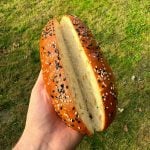Potato Hot Dog Buns
These potato hot dog buns are soft, fluffy & the perfect size for jumbo hot dogs! We're making these with roasted potato, for maximum flavour.
Servings: 4 Buns
Equipment
- Stand Mixer
- Digital Food Probe
- Potato Ricer
- Dough Scraper
- A Ruler
- Baking Tray
- Pastry Brush
Ingredients
Potato Dough
- 1 Large Potato (around 200g) (See Notes)
- 1 tbsp Vegetable Oil
- 250 g Strong White Bread Flour (See Notes)
- 6 g Fine Sea Salt
- 4 g Fast Action/Instant Yeast
- 10 g Caster Sugar
- ½ tsp Skimmed Milk Powder (Optional)
- 70 g Whole Milk
- 45 g Water
- 1 Large Egg
- 30 g Unsalted Butter (Softened)
Egg Wash
- 1 Egg
- 1 tsp Cold Water
- A Pinch Of Table Salt
To Finish
- 1 tsp Sesame Seeds (See Notes)
- 20 g Unsalted Butter (Melted)
Instructions
- Preheat an oven to 200°c/180°c fan (390°f/350°f).
- Place your potato onto a baking tray, drizzle with the vegetable oil then bake in the preheated oven until the skin is crispy & the inside is soft. This will take roughly 45 minutes.Poke a knife into the potato to check whether it is cooked. Once the potato is cooked, you can turn your oven off & preheat it again, later on.
- Let the potato cool slightly then cut in half & scoop out the flesh. Use a potato ricer (or fork) to mash the potato then weigh out 100g.
- Chop the crispy potato skin into small pieces then add into the mash potato. Leave to cool to room temperature.
- Place the flour, mash potato (and skin), salt, yeast, sugar, milk powder & egg into the bowl of a stand mixer.
- Next, place the milk & water into a jug & warm in a microwave to 38°c/100°f (alternatively you could heat this up in a saucepan), then pour into the flour.
- Using the dough hook, knead the dough on a medium speed until smooth & starting to come away from the sides of the bowl. This will take around 5 minutes.
- With the mixer still going, add in the butter a small amount at a time, incorporating each piece fully before adding more. Once all the butter has been incorporated, keep mixing until the dough passes the window pane test. This will take another 5-10 minutes.
- Transfer the dough to a lightly oiled bowl, cover with clingfilm or a tea towel & leave to double in size at room temperature. This will take 45 minutes – 1 hour.
- Once risen, knock the dough back then transfer to a lightly floured work surface. Using a bench scraper, divide the dough into 4 equal pieces, each weighing around 150 grams. Shape each piece into a ball then leave to bench rest for 10 minutes, covered with a damp tea towel.
- To shape, take a ball of dough, flip it over then press it down with the palm of your hand, into a ½" thick disc. Next, starting at the side closest to you, roll the dough into a tight cylinder then gently roll with your hands, to bring the dough to a length of 6½ inches & to seal the bottom.
- Transfer to a lined baking tray & repeat with the remaining dough.
- Once shaped, cover with another baking tray (flipped upside down) or loosely with oiled clingfilm & leave to double in size at room temperature. This will take 30 – 45 minutes.
- In the meantime, turn your oven back on & preheat to 180°c/160°c fan (350°f/320°f).
- Combine the egg & water with a pinch of table salt then brush the buns generously with the egg wash.
- Sprinkle the top of each bun with sesame seeds then bake in the preheated oven for 15-20 minutes, until a deep, golden brown.
- Once baked, brush each bun with melted butter then leave to cool completely.
Notes
1. Cooking In An Aga – Cook the potato on the bottom set of runners in the roasting oven. The buns need to be baked in the baking oven, on the bottom set of runners.
2. Potato – To get 100g of mashed potato, we’ll need to cook a raw potato that weighs around 200g. This ensures that we will have enough, any extra can be eaten or saved for something else.
3. Sesame Seeds – The sesame seeds that go on top of the buns can be white, black or a mixture of both. Or you can leave them out completely.
4. Storage – Kept in an airtight container, these buns will last several days at room temperature. Or you can store them in the fridge for a couple days extra shelf life.
5. Yeast – These buns are made with instant/fast action yeast but dried active yeast can be used instead. Keep in mind that dried active yeast will need to be activated in the warm milk & water first and will take slightly longer to prove. To activate, whisk the yeast into the liquid then leave for 5-10 minutes, to go frothy.
6. Flour – The flour I use is a Canadian white bread flour from Shipton Mill. You can use any bread flour but I get the best results using this one.
7. Milk Powder - Adding milk powder to the dough is optional but improves the colour of the baked buns. Skimmed or whole milk powder will work (I use skimmed).
